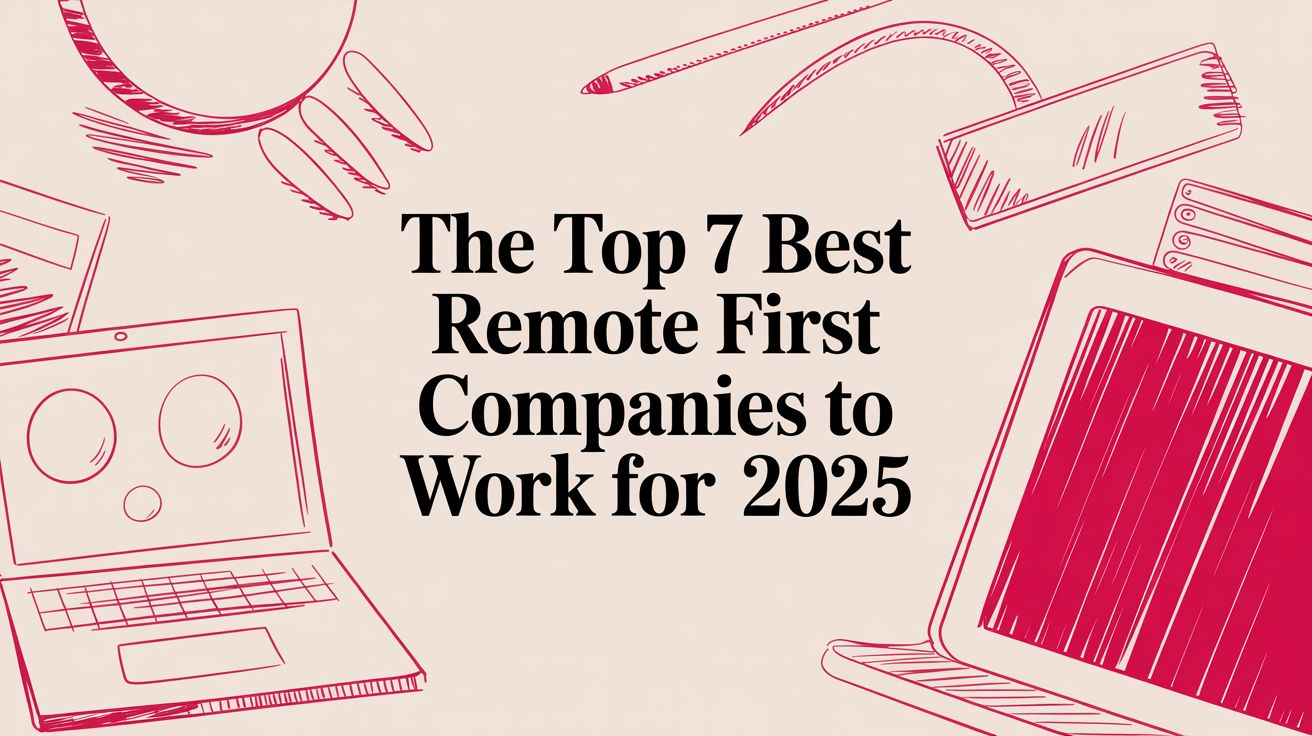What is Skills Based Hiring? Learn Key Strategies
Max
Skills-based hiring flips the script on traditional recruiting. Instead of focusing on credentials like degrees, fancy job titles, or a specific number of years on the job, it prioritizes a candidate’s actual abilities and competencies.
It’s a fundamental shift from evaluating who someone is on paper to what they can actually do.
Moving Beyond Resumes From Pedigree To Proficiency

Think about it this way: if you needed to hire a chef, would you care more about where they went to culinary school, or could they actually cook an incredible meal? A traditional approach might screen for graduates of top schools. A skills-based approach would hand them a knife and ask them to cook.
The proof is in the proficiency, not the pedigree.
This is the real heart of What Is Skills Based Hiring?. It’s a practical method that looks at demonstrable skills—both the technical stuff like coding or data analysis and the crucial soft skills like communication and problem-solving. This approach recognizes that real talent isn’t confined to a single educational path or a neat, linear career.
The Shift From Credentials To Capabilities
For decades, the bachelor’s degree was the default filter, a stand-in for a candidate’s potential. But that thinking is outdated. It often screens out incredibly talented people who built their expertise through apprenticeships, certifications, self-study, or just plain hard work.
The modern workplace is finally catching on. A recent survey from the National Association of Colleges and Employers found that nearly two-thirds of employers are now using skills-based practices to find the right people. Meanwhile, old-school metrics like GPA are fading away, with less than 40% of employers using them for screening anymore.
This isn’t just a small tweak; it makes the entire hiring process more inclusive and effective. Here’s how:
- It widens the talent pool. You suddenly have access to skilled candidates from all walks of life who might have been overlooked before.
- It improves job fit. By focusing on the exact skills needed for the role, you hire people who can hit the ground running and truly succeed.
- It boosts equity and diversity. This method naturally reduces the bias that can come from fixating on prestigious university or company names, leveling the playing field for everyone.
Skills-based hiring doesn’t mean you ignore experience or education. It just means you rebalance the equation. You prioritize what someone can contribute, not just the logos on their resume.
Skills Based Hiring vs Traditional Hiring at a Glance
To really see the difference, let’s compare how each approach might look when hiring for a digital marketing role.
| Aspect | Traditional Hiring (Focus on Pedigree) | Skills Based Hiring (Focus on Proficiency) |
|---|---|---|
| Initial Screening | Scans resumes for a marketing degree and 5+ years of agency experience. | Looks for evidence of skills like SEO, PPC, and content creation, regardless of source. |
| Interview Focus | Asks about past job titles, responsibilities, and where they went to college. | Asks behavioral questions focused on past projects and problem-solving scenarios. |
| Evaluation Method | Relies on self-reported experience and the prestige of past employers. | Uses a practical assessment, like creating a sample social media campaign or analyzing performance data. |
| Key Question | “Where have you worked before?” | “Can you show us how you would drive engagement?” |
The table makes it clear: one method relies on proxies, while the other demands proof. A skills-first approach gives you a direct look at a candidate’s capabilities, leaving no room for doubt.
Ultimately, this strategy is more than just a passing trend—it’s a smarter way to build a workforce. It aligns your hiring process directly with what your business actually needs, creating teams that aren’t just qualified on paper but are ready to deliver real results.
Understanding the Rise of Skills Based Hiring
The move toward skills-based hiring isn’t just another passing trend. It’s a direct, practical response to some deep-seated shifts in our economy. Companies aren’t just jumping on a bandwagon; they’re adopting this model because the old ways of finding talent simply aren’t working anymore.
Three massive forces are pushing this change forward: widening skills gaps, the declining relevance of college degrees, and the breakneck speed of technology. When you put them all together, you get a perfect storm that makes focusing on what a person can actually do a business necessity.
The Problem With Paper Credentials
For decades, a college degree was the gold standard—a simple, clean filter for recruiters buried under a mountain of resumes. It was a reliable shortcut for gauging capability. But that shortcut has become a dead end, especially for roles that demand highly specialized, up-to-the-minute expertise.
Think about a tech company desperately hunting for a cybersecurity expert. The job description demands a bachelor’s in computer science, so they interview a dozen candidates who check that box. Yet, none of them can truly defend a network against modern, sophisticated threats.
Meanwhile, a self-taught candidate with a GitHub portfolio full of successful penetration tests and defensive coding projects gets automatically rejected by the applicant tracking system. This person has the proven skills, but not the piece of paper. The company’s rigid reliance on degrees just cost them the best person for the job.
This exact scenario plays out every single day, across every industry imaginable. Businesses are finally waking up to the fact that a diploma from four, eight, or even twenty years ago doesn’t guarantee current competence. The skills that matter are evolving faster than university curricula can keep up.
Responding to a Changing Economic Landscape
Technology is constantly creating new jobs while making others obsolete. The skills that are in high demand today might be an afterthought in five years. This constant churn means companies have to be much more agile in how they find and grow their teams.
A skills-first approach gives organizations the flexibility to react. Instead of waiting for the perfect resume to land on their desk, they can spot people with adjacent skills—related abilities that can be quickly trained up to meet new challenges.
This adaptability is a survival trait. As automation and AI continue to reshape entire job functions, a person’s core competencies become far more valuable than their past job titles. This new reality also empowers job seekers. If you’re looking to make a career change, check out our guide on how to find remote work that plays to your strengths.
The momentum here is undeniable. A McKinsey report highlights just how fast this is happening, noting that the percentage of companies using skills-based hiring practices jumped from 40% in 2020 to 60% in 2024. That’s a 50% increase in just four years—a clear signal that the focus has shifted from degrees to demonstrable skills.
Building a More Resilient Workforce
At the end of the day, the rise of skills-based hiring is all about practicality. It solves real business problems by creating a smarter, fairer, and more effective way to build teams. When companies break free from the old credential-first mindset, they unlock some serious advantages:
- Access to Untapped Talent: They can finally find incredible candidates from non-traditional backgrounds, massively expanding their talent pool.
- Improved Job Performance: Hiring for specific, proven skills leads to a much better job fit, which means higher productivity and happier, more engaged employees.
- Greater Equity and Diversity: It levels the playing field, cutting down on unconscious bias and opening doors for people from all walks of life.
This isn’t about dismissing education. It’s about rebalancing priorities and acknowledging that talent doesn’t follow a single, predictable path. By focusing on what people can do, not just what they’ve studied, businesses can build the resilient, adaptable, and high-performing teams they need to win.
Building Your Skills-Based Hiring Framework
Making the switch from theory to practice takes a clear, actionable plan. Building a skills-based hiring framework isn’t about tearing down your old system. It’s more like a strategic renovation—you keep the solid foundation but update the rooms for how people actually live and work today.
This process means getting crystal clear on the skills you need, rewriting your job description “blueprints” to match, and finding new ways to measure a candidate’s real-world craftsmanship through smart, targeted assessments.

Defining Your Skills Taxonomy
Before you can hire for skills, you have to know what they are. A skills taxonomy is basically your company’s unique dictionary for the competencies that drive success. Think of it less like a list and more like a structured map that helps everyone—from recruiters to hiring managers—speak the same language about talent.
A good place to start is by breaking skills into a few distinct categories:
- Hard Skills: These are the teachable, technical abilities that are pretty easy to measure. We’re talking about proficiency in a programming language, operating specific machinery, or building a financial model.
- Soft Skills: These are the interpersonal traits that dictate how someone works and gels with a team. Things like communication, collaboration, and adaptability fall in this bucket. They’re often tougher to quantify but are absolutely critical.
- Adjacent Skills: These are related abilities that signal a candidate’s potential to grow. For example, a graphic designer with a knack for data visualization might be a fantastic future data analyst with just a bit of training.
By creating this taxonomy, you’re setting a clear standard for what “good” looks like in every role, moving far beyond vague job titles.
Rewriting Job Descriptions for Competencies
Your job descriptions are the front door to your company. Too often, they act as a barrier, loaded with degree requirements and arbitrary years of experience that filter out perfectly capable people. A skills-based job description, on the other hand, is a welcome mat.
The entire goal is to shift the focus from credentials to competencies. So, instead of demanding a “Bachelor’s degree in Marketing,” you specify “demonstrated experience running successful PPC campaigns with measurable ROI.” That small tweak can open up your talent pool in a huge way.
A skills-based job description should answer one fundamental question for the candidate: “What will I need to be able to do to succeed in this role?” It focuses on outcomes and abilities, not just background.
This approach doesn’t just attract a more diverse slate of applicants; it also sets clear expectations from the very first touchpoint. As hiring evolves, so do workplace expectations. To learn more about what top talent is looking for, check out the many remote work benefits that skilled professionals are prioritizing today.
Choosing Effective Skills Assessments
Once you’ve attracted candidates based on the skills you need, you have to find a reliable way to verify them. A resume tells you what someone claims they can do; assessments show you what they can actually do. The trick is to use methods that directly mirror the real work.
Some of the most common and effective assessment types include:
- Work Sample Tests: Give the candidate a small task that’s a core part of the job. For a content writer, ask them to draft a short blog intro. For a developer, have them debug a snippet of code.
- Situational Judgment Tests (SJTs): Present applicants with realistic workplace scenarios and ask how they’d handle them. This is a brilliant way to see soft skills like problem-solving and decision-making in action.
- Technical Challenges: For roles in engineering or IT, use platforms like HackerRank or a custom-built technical problem. This gives you objective proof of their hard skills.
These assessments give you tangible data, shifting your hiring decision from a gut feeling to an evidence-based conclusion.
Training Managers to See Potential
The final—and arguably most critical—piece of the puzzle is your people. Your hiring managers need to be trained to shift their mindset from just reviewing a resume’s past to truly assessing a candidate’s future potential.
This means coaching them to look for core competencies and transferable skills instead of getting hung up on specific job titles or big-name companies on a CV.
Effective training should give your managers the tools to:
- Run structured, behavior-based interviews that focus on past actions and outcomes.
- Objectively evaluate assessment results using a standardized rubric.
- Recognize and actively mitigate the unconscious biases that favor traditional candidates.
When you empower your hiring managers with these new tools, you complete the skills-based framework. The whole process becomes aligned around one thing: identifying and hiring the absolute best talent, regardless of where they come from.
Implementing a Skills-Based Hiring Strategy

Alright, so you’re sold on the idea. But how do you actually make the switch to skills-based hiring? It’s not something you can flip a switch on overnight. Think of it as a journey, not a sprint.
The best way to get started is with a phased rollout. You begin small, prove the concept, build some momentum, and bring your team along for the ride. It all starts with getting leadership on board, picking the right guinea pigs for a pilot, and fundamentally rethinking what a “job” really is.
Gaining Leadership Buy-In
Before you change a single job description, you need the folks in the corner offices to understand the why. This isn’t just another HR pet project; it’s a core business strategy that builds a more agile and competitive workforce. You need to speak their language: tangible business outcomes.
To build a rock-solid case, lean on the data:
- Show Them the Money Drain: Talk about the real costs of your current process. Point to high turnover rates, how long it takes to fill critical roles, and the hidden expense of hiring someone who looks great on paper but can’t actually do the job.
- Highlight the Potential ROI: Explain how hiring for skills directly impacts the bottom line. You’ll see better performance, fewer hiring mistakes, and a real boost in innovation.
- Tie It to the Big Picture: Connect your proposal to what the company is already trying to achieve. Are you expanding into new markets? Trying to improve diversity? Closing a massive skills gap? Show them how this is the key.
When leaders see how this approach solves real-world business problems and drives growth, getting their support becomes a whole lot easier.
Starting With a Pilot Program
Don’t try to boil the ocean. Instead of a massive, company-wide overhaul on day one, pick one or two departments—or even a single high-impact role—for a pilot program.
This lets you test your new process on a smaller scale, work out the kinks, and learn as you go. It minimizes risk and, more importantly, builds confidence across the entire organization. Find a department with a manager who’s open to new ideas and is feeling the pain of bad hires. Their partnership will be gold.
A successful pilot program becomes your most powerful internal case study. When other departments see the quality of talent you’re bringing in and how much faster you’re doing it, they’ll be lining up to be next.
The momentum here is undeniable. By 2024, this approach was already becoming the go-to method for finding top talent. Data from Radancy’s 2025 analysis shows that a staggering 81% of employers had adopted skills-based hiring, a huge leap from just 57% in 2022. It’s a clear signal that the world is shifting to prioritize what people can do, not just where they’ve been.
Auditing Roles and Rewriting Job Descriptions
With your pilot team in place, it’s time for the fun part: dissecting the job itself. Sit down with the hiring manager and break the role down into its core components. Forget the old list of credentials for a minute and ask the most important question:
“To be truly successful, what does a person in this role need to accomplish every single day?”
That conversation is the foundation for rewriting your job descriptions. The goal is to turn them from exclusive wish lists into inclusive invitations for anyone with the right skills.
- Scrap the Barriers: Get rid of degree requirements unless they are an absolute legal or regulatory must-have. Do the same with arbitrary “years of experience” demands.
- Focus on What Matters: Replace credential lists with action-oriented statements. Instead of “5+ years of marketing experience,” try “Proven ability to manage a digital ad budget to achieve a positive ROI.” See the difference?
- Use Welcoming Language: Make sure the tone is approachable and ditch the corporate jargon that might scare away perfectly good candidates from different backgrounds.
Establishing Metrics to Track Success
If you can’t measure it, you can’t prove it worked. Before you even start your pilot, you need to define what success looks like. Establish clear key performance indicators (KPIs) and track them religiously. This is the data that will justify rolling this out to the whole company.
Consider tracking a few key metrics:
- Time-to-Fill: Are you finding qualified people faster?
- Quality of Hire: How are the new hires performing after 90 days? A year?
- Diversity Metrics: Is your candidate pool—and your new hires—becoming more diverse?
- Employee Retention: Are the people you hire this way sticking around longer? For more ideas here, you might be interested in our guide on how to improve employee retention.
Follow these steps, and you’ll build a clear, defensible, and scalable path toward making skills the true currency of talent at your organization.
How Leading Companies Win with Skills Based Hiring
Theory is one thing, but seeing a strategy actually deliver results in the real world is what really matters. The good news is that skills-based hiring isn’t some unproven academic concept; it’s a powerful engine driving success at some of the world’s most recognizable companies.
These industry leaders aren’t just tweaking their old hiring processes. They’re fundamentally rethinking how they find, attract, and grow talent. What they’ve found is that focusing on what people can do—not just their pedigree—is the key to building a resilient, high-performing workforce.
Let’s dig into how they’re making it happen.
IBM and the Rise of “New Collar” Jobs
IBM has been a true pioneer in this space for years. Facing a massive tech skills gap, the company knew it couldn’t rely solely on traditional four-year degrees to find the talent it needed for roles in cybersecurity, cloud computing, and AI.
Their solution? Championing the idea of “New Collar” jobs. These are roles that put specific, in-demand technical skills first, way ahead of a specific educational background. IBM basically shifted its focus from where a candidate learned something to what they could actually accomplish.
This led to some big changes:
- Apprenticeship Programs: IBM launched robust, paid apprenticeship programs that create a direct pipeline of skilled talent trained on the job.
- Skills-Based Credentials: They started valuing industry certifications and digital badges (like those from their own SkillsBuild platform) as legitimate proof of expertise.
- Job Description Overhaul: They systematically stripped degree requirements from job postings where they weren’t truly essential, opening the door to a much wider, more diverse group of applicants.
The results speak for themselves. Today, a significant chunk of IBM’s U.S. workforce doesn’t have a traditional four-year degree, proving that great talent comes from all kinds of places.
Google’s Data-Driven Revelation
Google is famous for its data-obsessed culture, and its approach to hiring is no different. For years, the company prized candidates from elite universities. But after digging into their own internal performance data, they stumbled upon a surprising discovery: academic credentials had little to no correlation with on-the-job success.
That insight sparked a major shift. Google began to de-emphasize GPAs and alma maters, focusing instead on assessing four key attributes: general cognitive ability, leadership, role-related knowledge, and “Googleyness” (a mix of conscientiousness and intellectual humility).
Google’s shift wasn’t just about fairness; it was a cold, hard business decision. Their data proved that practical assessments and structured interviews were far better predictors of high-performing employees than any university name on a resume.
To measure these traits, they lean heavily on practical assessments. For tech roles, this often means live coding challenges. For other positions, it might be a work sample test or a hypothetical problem-solving scenario. This ensures every hiring decision is based on tangible proof that a candidate can do the job.
Bank of America’s Investment in Local Talent
Bank of America took a more community-focused approach. To fill crucial roles while also creating economic opportunity, the company launched “The Academy,” a massive internal training and development program.
A key part of their strategy is partnering with community colleges. They work together to develop curricula that directly align with the skills needed for jobs in banking, tech, and customer service. This creates a clear, accessible path to a career for people who might not have considered a four-year university degree.
By investing in local skills development, Bank of America doesn’t just fill its own talent pipeline—it strengthens the communities it serves. It’s a powerful example of how skills-based practices can be a win-win for both companies and local economies. Of course, managing this talent effectively, especially in distributed settings, requires strong leadership. For actionable advice, check out our guide on the 7 best practices for virtual teams in 2025.
Impact of Skills Based Hiring in Leading Companies
The shift towards skills-based hiring isn’t just about feeling good; it’s about driving tangible business outcomes. The table below highlights how some of the biggest names in the industry have benefited from prioritizing what candidates can do over where they went to school.
| Company | Key Initiative | Reported Outcome 1 | Reported Outcome 2 |
|---|---|---|---|
| IBM | Championed “New Collar” jobs, removing degree requirements. | 50% of their U.S. workforce now comes from non-traditional backgrounds. | Increased access to talent in high-demand fields like cybersecurity and AI. |
| Shifted focus from academic pedigree to skills assessments. | Found no correlation between university prestige and employee performance. | Improved hiring accuracy by focusing on cognitive ability and practical skills. | |
| Bank of America | Partnered with community colleges for talent development. | Filled 10,000 jobs from low- and moderate-income neighborhoods. | Created a sustainable talent pipeline while investing in local communities. |
| Accenture | Dropped degree requirements for a majority of entry-level roles. | Increased applicant pool diversity by tapping into overlooked talent. | Shortened time-to-hire by focusing on skills validation over credential checks. |
As you can see, the data is clear. From expanding talent pools to improving on-the-job performance, skills-based hiring offers a competitive advantage that’s impossible to ignore. These companies prove that when you bet on skills, you win.
Here is the rewritten section, crafted to sound human-written and align with the provided examples.
The Future of Talent Is Built on Skills
So, we’ve established that skills-based hiring is much more than just a new recruiting buzzword. Think of it less as a tactic and more as a complete talent philosophy. It’s a strategic pivot that changes how you find, grow, and keep your best people—your most valuable asset. This isn’t just about tweaking job descriptions; it’s a fundamental shift to seeing what someone is capable of, not just what’s listed on their resume.
This focus on skills is only going to become more important. The future of work demands an agile and adaptable team, and a skills-first mindset is really the only way to build one. It fosters a dynamic internal talent marketplace where employees are actually encouraged to pick up new competencies and can see a real future for themselves inside the company. This shift has a direct line to everything from employee engagement to how you plan your workforce for the long haul.
The Role of Technology in Scaling Skills
Let’s be real: doing this manually for a large organization is a nightmare. This is where new technology, especially AI, comes in to really move the needle. AI-powered platforms will make it so much easier to:
- Identify Skills at Scale: Scan employee profiles and performance data to create a living map of the skills you already have across the entire organization.
- Assess Candidates Objectively: Use smart simulations and assessments to get a true read on a candidate’s abilities, cutting through the usual unconscious bias.
- Match Talent to Opportunity: Intelligently connect both internal and external candidates to roles where their specific skills can make the biggest splash.
The end game here is to build a talent ecosystem where skills are the universal currency. Technology is the engine that runs this economy, making sure you have the right skills in the right place at exactly the right time.
Your Role in Championing Change
Ultimately, buying into skills-based hiring is a call to action for every leader, hiring manager, and HR pro out there. It’s your chance to build teams that are more resilient, fair, and flat-out better at what they do. By focusing on what people can do instead of just where they’ve been, you unlock a ton of untapped potential and get your organization ready for whatever challenges are coming next.
Frequently Asked Questions About Skills Based Hiring

Switching to a skills-based approach is a big move, and it’s totally normal to have questions. It’s a different way of thinking about talent, so let’s walk through some of the things recruiters and hiring managers wonder about when they start to dig in.
Is Skills Based Hiring More Time Consuming?
Let’s be honest: there’s an upfront investment. You’ll spend time rewriting job descriptions and designing solid skills assessments. But that initial effort pays off big time down the road.
Think about it. When you focus on skills from day one, you attract people who can actually do the job. That means less time wasted sorting through piles of irrelevant resumes. Your interview process becomes way more efficient, you make fewer hiring mistakes, and your time-to-fill shrinks for future roles.
How Can You Accurately Assess Soft Skills?
This is a big one. How do you measure something like collaboration or problem-solving without it feeling like a guessing game? The key is to move beyond the usual “tell me about a time when…” questions.
There are structured ways to get real evidence of these abilities:
- Behavioral Interviews: Go deep. Ask candidates to walk you through specific situations from their past, focusing on what they did and what the outcome was.
- Situational Tests: Give them a realistic workplace scenario. “A key client is upset about a missed deadline. What’s your first move?” Their answer tells you a lot about their judgment and how they handle pressure.
- Collaborative Projects: For your final candidates, try a short group task. You’ll see their teamwork and communication skills in action, not just hear about them.
When you use techniques like these, you create a process that feels fair and relevant. That directly improves the what is candidate experience because applicants can see they’re being evaluated on what truly matters.
A skills-first model isn’t about throwing degrees and resumes in the trash. It’s about shifting the balance so a candidate’s proven abilities carry the most weight.
Do Degrees and Experience No Longer Matter?
Not at all. This is probably the biggest misconception out there. Skills-based hiring doesn’t make education or experience worthless; it just puts them in their proper place. A degree shows dedication, and years on the job can suggest deep expertise.
But neither one is a guarantee of performance. This approach puts demonstrable skills at the very top of the list, treating degrees and traditional experience as supporting evidence rather than the main event.
What Tools Can Help with Skills Assessments?
You don’t have to build everything from scratch. There are plenty of great platforms out there that make it easy to integrate skills assessments into your hiring process. They offer objective, scalable ways to see what a candidate can really do.
A few types to look into:
- Coding Challenge Platforms: If you’re hiring developers, these are a must. They offer standardized tests to evaluate real programming skills.
- Work Sample Software: These tools let you create your own custom tests that mimic the actual tasks the person will be doing in the role.
- Pre-employment Assessment Tools: Many of these platforms have huge libraries of tests for everything from data analysis to leadership potential.


